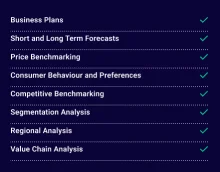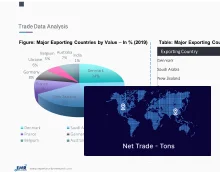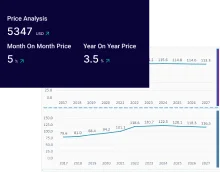
Consumer Insights
Uncover trends and behaviors shaping consumer choices today
Procurement Insights
Optimize your sourcing strategy with key market data
Industry Stats
Stay ahead with the latest trends and market analysis.
Trending Now



The global occupancy sensor market was valued at USD 2830.15 Million in 2024. The industry is expected to grow at a CAGR of 12.80% during the forecast period of 2025-2034. The growing demand for energy-efficient and sustainable applications among different verticals is the primary growth driver of this market. With the use of occupancy sensors, wasted energy can significantly be cut down by employing lighting, HVAC, and other systems only when the respective area is occupied, thus saving the energy that would otherwise have been used in unoccupied spaces. Environmental regulations have made occupancy sensors one of the trending applications in corporate energy management strategies. In turn, all these factors have resulted in the market attaining a valuation of USD 9438.45 Million by 2034.
Base Year
Historical Year
Forecast Year






Value in USD Million
2025-2034
Occupancy Sensor Market Outlook
*this image is indicative*
The occupancy sensor market growth is being fueled primarily by the demand for energy-efficient solutions worldwide across residential, commercial, and industrial sectors. Occupancy sensors are devices that sense whether there is a person present or not in any demarcated area, thereby allowing control in terms of lighting, heating, ventilation, and air conditioning (HVAC) functions. Hence, they help optimize energy consumption and improve operational efficiency. Hoarding energy conservation is mainly a priority because energy prices are increasing. As a result, the future acceptance of occupancy sensors is expected to soar. For instance, occupancy sensor lights may become cost-effective measures whereby they offer energy savings of 24% usage. Apart from that, price becomes a significant factor for businesses trying to reduce common operational costs. Moreover, wireless sensors are gaining rapid popularity as they provide easy installation and flexibility and are relatively low maintenance. This sensor type is likely to expand the market as well.
The increased penetration of smart building solutions and the Internet of Things (IoT) are also propelling the market growth further. All these sensors can be incorporated into a smart system for monitoring and automating energy use; hence delivering efficient energy use and even more information to manage the facility. Due to the green building movement and energy conservation re-enforcements, the global occupancy sensor market is likely to grow considerably more in the upcoming years.
The most significant niche driving overall growth in the occupancy sensor market is the development and adoption of wireless occupancy sensors for smart buildings. These sensors have become increasingly popular in buildings, where energy management, security, and comfort have been enhanced with interfacing systems. Wireless occupancy sensors reduce the need for complicated wiring and costlier installation, specifically in retrofit or existing situations. They can easily serve as a wireless addition when connected with building management systems (BMS) or platforms based on the Internet of Things (IoT) to enable real-time occupancy data monitoring. This data may then be used in modifying HVAC systems, lighting, and security parameters. This niche is increasingly gaining momentum as businesses search for more flexible, scalable, and energy-efficient options to yield enhanced operational efficiency and achieve their sustainability targets.
Using occupancy sensors in healthcare facilities, such as hospitals and clinics, represents another niche segment existing in the occupancy sensor industry. Such types of sensors are designed to provide significant improvements in energy efficiency, operational cost savings, and enhancement of patient safety. Occupancy sensors, for instance, can control lighting and HVAC equipment to be active based on actual room utilization so that energy is saved at the unoccupied places of the facility. With healthcare facilities increasingly turning their focus to eco-friendly facility operations, environmental concerns, and improving resource management, the demand for occupancy sensors designed for healthcare environments will are projected to rise in the upcoming years.
The key trends influencing growth in the occupancy sensor market are growing demand in smart homes, increased adoption of energy-efficient solutions, increased integration of IoT and Building Managment Systems, and growth of wireless battery-powered sensors.
As smart home technology grows, occupancy sensors are being widely integrated into home automation systems. They are used for controlling lighting, HVAC systems, and security, enhancing energy efficiency and convenience and contributing to rising occupancy sensor demand. As per the industry reports, around 75% of consumers in the United States possess smart devices within their homes. The trend towards smart home technology has been steadily increasing over the years. The launch of a new standard called Matter is revolutionizing the smart home sector by improving the compatibility of devices from different manufacturers. This development is encouraging wider adoption of smart home technologies by addressing the cross-platform compatibility issues, thereby aiding the growth of occupancy sensor market.
Several government bodies are focusing on reducing energy consumption, and occupancy sensors play a significant role in this by automatically adjusting lighting and temperature based on room usage, cutting down unnecessary energy use. The European Union has set some stringent energy efficiency goals through its Energy Efficiency Directive (EED), which is part of the European Green Deal. These goals require buildings to adopt automated systems, such as occupancy sensors, to reduce unnecessary energy consumption, contributing to the occupancy sensor market value. Moreover, in India, the government, through the Bureau of Energy Efficiency (BEE), encourages the adoption of occupancy sensors to improve energy-efficient lighting in both residential and commercial settings. The BEE's Energy Conservation Building Code (ECBC) mandates that commercial buildings must implement energy-efficient lighting controls, including occupancy sensors.
Another emerging trend in the occupancy sensor market is the rising integration of occupancy sensors with IoT and Building Management Systems (BMS). This trend is propelling the development of advanced and interconnected ecosystems where sensors communicate with devices. IoT-enabled occupancy sensors are even capable of providing real-time data used in monitoring and controlling energy consumption of HVAC, lighting, and security systems. The capacity to collect and analyze information from multiple sources helps facility managers with informed decisions when it comes to improving operation effectiveness and increasing user comfort. This trend is especially apparent in commercial contexts where increasing demands for smart, connected solutions are required.
Another trend upending the occupancy sensor market is the increasing requirement for wireless and battery-operated occupancy sensors. Wireless sensors are way more cost-effective compared to the wired counterparts that require labor charges for cabling and finishing. These sensors can even be installed in the most unlikely of areas, making maintenance not at all a hassle. Due to advancements in battery technology, many wireless sensors have become durable post installation, plus they require minuscule maintenance or renewals. This trend also aligns with the general movement towards convenience and adaptability in commercial, industrial, and residential spaces as businesses and consumers both increasingly seek low-cost, sustainable, and easy solutions to install.
Wireless occupancy sensors integrated Internet of Things (IoT) have opened up vast possibilities of growth in the market. These sensors are becoming more advanced, offering real-time data, remote monitoring, and integration with other smart devices. For instance, the integration of IoT technology in smart buildings, especially through the use of occupancy sensors, is expected to improve energy efficiency and automation and contribute to occupancy sensor market revenue. There is an increasing demand for smart buildings that implement IoT occupancy sensors for managing lighting and climate control, as these systems have the potential to reduce energy consumption by up to 30%.
Occupancy sensors are increasingly being integrated with comprehensive building management systems, allowing centralized control of lighting, HVAC, and security, leading to better energy management and operational efficiency. For instance, Johnson Controls offers solutions that integrate occupancy sensors into its Metasys Building Automation System (BAS). This system enables centralized control of HVAC, lighting, and security by using occupancy sensors to detect when specific rooms or areas are in use and contributes to the demand of occupancy sensor market. As a result, it can automatically adjust temperature settings and lighting, reducing unnecessary energy consumption. Honeywell has also developed smart building solutions that link occupancy sensors to building management platforms, allowing for real-time monitoring and adjustments across lighting, security, and HVAC systems. Such exclusive innovations have created good scope for occupancy sensor market companies to grow.
The increasing number of regulatory mandates and green building codes, which require energy-efficient technologies in commercial and residential buildings is boosting the occupancy sensor market growth. In line with this trend, government agencies around the world are introducing policies to reduce carbon footprints in addition to sustainable building practices. For example, LEED certifies practices, such as use of energy-efficient technologies, including occupancy sensors. These regulations spur adoption of the above technologies and further create a competitive market in which owners of buildings would seek to get higher energy ratings. hence, occupancy sensors would be a solution to the growing environmental standards.
The growth of occupancy sensor market revenue is also heavily impacted by advanced developments in sensor technologies and the advancement of sensors into accuracy, versatility, and affordability. Countless modern sensor innovations, including improved motion detection algorithms, more effective wireless capability, longer battery life, considerable upgradation of features, and wider applications, have made occupancy sensors more optimal for usage in almost all types of industries including residential buildings to enormous business areas. Advancements in sensor technologies are making these sensors fit into smart systems and IoT platforms, which considerably drives adoption in all sectors.
“Occupancy Sensor Market Report and Forecast 2025-2034” offers a detailed analysis of the market based on the following segments:
Market Breakup by Network Connectivity
Market Breakup by Technology
Market Breakup by Operation
Market Breakup by Building Type
Market Breakup by Application
Market Breakup by Region
Insights by Network Connectivity
Wireless sensors account for a major occupancy sensor market share as they are much easier to integrate with smart building systems and IoT networks, which are becoming more common in modern building automation systems. Wired occupancy sensors provide very stable, high-performance connections with minimum interference, which is useful and practical for larger installations where reliability is critical. Wi-Fi connected sensors are easily integrated into already existing networks and are therefore quite flexible and scalable when it comes to homes and businesses that want to make smart system connections. Zigbee-based sensors capture capabilities in the mesh networks in low power consumption; therefore, they make a great solution for large commercial spaces and smart buildings with multiple devices communicating reliably and securely with one another. The energy harvested from the EnOcean technology permits occupancy sensors with zero-maintenance batteries and, thus, lowers potential maintenance costs while providing a self-powered, sustainable solution for smart buildings and green initiatives.
Market Analysis by Technology
Passive Infrared (PIR) sensors are generally less expensive to produce and install compared to ultrasonic and microwave sensors, thereby gaining major share in the occupancy sensor market. These are popular for a wide range of applications, especially in cost-sensitive projects like residential buildings and smaller commercial spaces. Ultrasonic occupancy sensors are extremely effective in detecting people and movement even in the most complicated layouts when used. This makes it possible to make use of large and oddly shaped spaces. Their sensitive detection capabilities of even small delicate movements give them greater performance in areas where accuracy is highly sought after, such as in offices or classrooms.
Market Insights by Operation
Indoor sensors are commonly used in various applications, such as offices, homes, schools, hospitals, retail stores, and industrial facilities, boosting growth of the occupancy sensor industry. The rise of smart buildings and homes, where automation and occupancy monitoring play a crucial role in reducing energy consumption, has further stimulated the adoption of indoor sensors. The growing adoption of outdoor occupancy sensors is driven by the increasing need for energy-efficient lighting and security solutions in public spaces, parking lots, and industrial areas. Additionally, advancements in sensor durability and weather-resistant technologies are enhancing their effectiveness and reliability in outdoor environments, promoting widespread use for smart city applications.
Analysis by Building Type
The commercial sector holds the highest share of the global occupancy sensor market. Commercial buildings, such as offices, retail stores, hospitals, and schools, require more advanced and widespread energy management solutions. Occupancy sensors are essential for optimising lighting, HVAC systems, and other utilities in large spaces, which significantly contributes to energy savings. With regard to residential buildings, there is a growing interest in energy efficiency in homes and smart automation, which is driving the adoption of occupancy sensors. Furthermore, increasing consumer preferences for convenience, security, and sustainable environments are expected to have a positive impact on the market for the most advanced and easy-to-install occupancy sensor solutions for homes.
Market Outlook by Application
Lighting control accounts for a substantial share of the occupancy sensor market as these are widely used for immediate energy savings by turning lights on or off based on the presence or absence of people in a room or space. This application has the most direct impact on reducing electricity consumption, especially in commercial and public buildings. The installation of occupancy sensors in HVAC systems leads to energy savings by interacting the room temperature and ventilation with the actual occupancy in a room. Occupancy sensors are also commonly equipped with detection and alarm functions in security systems. Many users deploy these detectors with alarms and alerts to indicate unauthorized presence. Microwave sensors have longer detection range and higher sensitivity compared to the other technologies which works great for large high-ceiling areas or places with very high traffic. These sensors can also sense motion through materials like glass and thin walls, hence, their usage extends to security and industrial applications as well.
North America Occupancy Sensor Market Growth
The North America occupancy sensor market growth is due to the strong demand for energy-efficient solutions, regulatory efforts to reduce energy usage, and advancements in the integration of Internet of Things (IoT) technologies in smart building systems. For instance, California's Building Energy Efficiency Standards mandate the use of occupancy sensors in commercial and public buildings to control lighting and HVAC systems, boosting occupancy sensor industry revenue. These regulations aim to minimize energy waste by ensuring that lighting is only turned on when areas are occupied. Furthermore, the state mandates the installation of sensors in outdoor lighting systems as well. The rapid development of commercial and institutional infrastructure in the United States also boosts market growth.
Europe Occupancy Sensor Market Trends
The Europe occupancy sensor market growth is fueled by stringent energy efficiency regulations and a strong commitment to sustainability in the region. As per the occupancy sensor market dynamics and trends, several government bodies in the region are increasingly mandating the use of occupancy sensors in buildings to meet carbon reduction goals. For instance, the EU Energy Efficiency Directive emphasizes the significance of smart building technologies, with occupancy sensors playing a crucial role in optimizing lighting and HVAC systems to reduce energy consumption. Further, occupancy sensors are expected to play a significant role in commercial and institutional settings, such as offices and hospitals in the region as they can improve the safety and efficiency of overall operations while minimizing wastage of energy.
Asia Pacific Occupancy Sensor Market Drivers
The occupancy sensor market in the Asia Pacific region is experiencing substantial growth, owing to the rapid urbanization and the development of smart city initiatives. Countries such as China, Japan, and India are readily adopting smart infrastructure, where occupancy sensors are essential for enhancing energy efficiency in buildings, boosting enormous opportunities for growth. Additionally, countries like Australia and New Zealand are placing greater importance on sustainability and energy efficiency within their building regulations. These policies are increasing the demand for occupancy sensors in residential and commercial environments, as they are widely known for minimizing energy usage.
Latin America Occupancy Sensor Market Dynamics
The Latin America occupancy sensor market is increasingly driven by smart city initiatives, especially in countries such as Brazil, Argentina, and Chile. These initiatives have led to the implementation of occupancy sensors in both commercial and public facilities. Furthermore, several government bodies are increasing investments in sustainable infrastructure, incorporating occupancy sensors as a primary component of their energy management approaches and boosting the occupancy sensor demand growth. This region is also experiencing advantages from rising awareness of cost-effective technologies within the real estate and construction sectors. The market has seen an increasing popularity of occupancy sensor technologies, as they provide accurate and reliable inputs for managing internal spaces.
Middle East and Africa Occupancy Sensor Market Outlook
The growth in occupancy sensor market in Middle East and Africa region is propelling forward by countries such as Saudi Arabia and the UAE are making significant investments in smart infrastructure to diversify their economies. The implementation of occupancy sensors is becoming popular in commercial real estate and industrial settings to enhance energy efficiency and lower operational expenses. The increasing use of passive infrared and ultrasonic sensors is expected to propel the growth in the region. This is because occupancy sensors rely on invisible infrared rays and high frequencies of sound waves to generate information about the optimum utilization of space and people’s movements. Additionally, the green building initiative and energy efficiency regulations are readily adopted, which boosts the demand for occupancy sensors in new construction projects.
Many occupancy sensor companies are developing sensors with smart capabilities, integrating them into the IoT ecosystems. These sensors can communicate with other smart devices, lighting systems, and HVAC systems to optimize energy usage based on room occupancy. Some occupancy sensor market players are further moving towards wireless and battery-powered occupancy sensors to simplify installation and maintenance.
Established in 1836, Schneider Electric SE is a multinational corporation based in France, specializing in energy management and automation solutions. The company focuses on electrical equipment, software, and services for energy efficiency and sustainability, helping customers optimize their energy use and reduce environmental impact.
Eaton Corp. Plc is a global power management company founded 1988 and headquartered in Ireland. The company enjoys a significant presence in electrical systems, components, and solutions for energy-efficient management.
Founded in 1906, Honeywell International Inc. is a diversified technology and manufacturing company with its headquarters in the United States. It operates in various sectors such as aerospace, building technologies, performance materials, and safety solutions.
Established in 2016, Signify N.V., formerly known as Philips Lighting N.V., is a Dutch multinational corporation. The company is ell-reputed for developing sensors as advanced energy-efficient solutions for smart lighting and building automation.
*Please note that this is only a partial list; the complete list of key players is available in the full report. Additionally, the list of key players can be customized to better suit your needs.*
Other major occupancy sensor market players are Johnson Controls International Plc, General Electric Co., Texas Instruments Incorporated, Legrand S.A., Lutron Electronics Co., Inc., Leviton Manufacturing Co., Inc., and Analog Devices, Inc., among others.
Startups in the market are focusing on adopting high-end technologies and niche applications to disrupt the traditional energy management and building automation space. Many startups in occupancy sensor market are using AI and machine learning to make occupancy sensors smarter, enabling them to learn from patterns of occupancy and predict future behavior. These AI-powered sensors can optimize building systems more dynamically by learning from usage trends, enhancing energy efficiency and reducing operational costs.
OccupEye
OccupEye is a UK-based startup that provides wireless occupancy monitoring solutions designed for offices, libraries, and public sector organizations. Its platform offers detailed insights into workspace utilization, helping different organizations to optimize their real estate and reduce overhead costs. The system collects and analyses occupancy data to better understand how space is used, making it valuable for facility management.
PointGrab
PointGrab is a startup that specializes in smart sensing technology for building automation. Their CogniPoint system uses advanced AI-powered sensors to detect and analyze the number and location of people within indoor spaces, making it ideal for smart offices and commercial buildings. PointGrab’s sensors can detect not only whether a space is occupied but also how it is being used, which is critical for optimizing large office spaces or shared work environments.
*While we strive to always give you current and accurate information, the numbers depicted on the website are indicative and may differ from the actual numbers in the main report. At Expert Market Research, we aim to bring you the latest insights and trends in the market. Using our analyses and forecasts, stakeholders can understand the market dynamics, navigate challenges, and capitalize on opportunities to make data-driven strategic decisions.*
Get in touch with us for a customized solution tailored to your unique requirements and save upto 35%!
In 2024, the market reached an approximate value of USD 2830.15 Million.
The occupancy sensor market is assessed to grow at a CAGR of 12.80% between 2025 and 2034.
The market is estimated to witness healthy growth in the forecast period of 2025-2034 to reach a value of around USD 9438.45 Million by 2034.
The different applications of occupancy sensor are HVAC, lighting control, and security and surveillance, among others.
The major regions in the market include North America, Europe, Asia Pacific, Latin America, and the Middle East and Africa.
The key market players are Schneider Electric SE, Eaton Corp. Plc, Honeywell International Inc., Signify N.V., Johnson Controls International Plc, General Electric Co., Texas Instruments Incorporated, Legrand S.A., Lutron Electronics Co., Inc., Leviton Manufacturing Co., Inc., and Analog Devices, Inc., among others.
Explore our key highlights of the report and gain a concise overview of key findings, trends, and actionable insights that will empower your strategic decisions.
| REPORT FEATURES | DETAILS |
| Base Year | 2024 |
| Historical Period | 2018-2024 |
| Forecast Period | 2025-2034 |
| Scope of the Report |
Historical and Forecast Trends, Industry Drivers and Constraints, Historical and Forecast Market Analysis by Segment:
|
| Breakup by Network Connectivity |
|
| Breakup by Technology |
|
| Breakup by Operation |
|
| Breakup by Building Type |
|
| Breakup by Application |
|
| Breakup by Region |
|
| Market Dynamics |
|
| Competitive Landscape |
|
| Companies Covered |
|
Datasheet
One User
USD 2,499
USD 2,249
tax inclusive*
Single User License
One User
USD 3,999
USD 3,599
tax inclusive*
Five User License
Five User
USD 4,999
USD 4,249
tax inclusive*
Corporate License
Unlimited Users
USD 5,999
USD 5,099
tax inclusive*
*Please note that the prices mentioned below are starting prices for each bundle type. Kindly contact our team for further details.*
Flash Bundle
Small Business Bundle
Growth Bundle
Enterprise Bundle
*Please note that the prices mentioned below are starting prices for each bundle type. Kindly contact our team for further details.*
Flash Bundle
Number of Reports: 3
20%
tax inclusive*
Small Business Bundle
Number of Reports: 5
25%
tax inclusive*
Growth Bundle
Number of Reports: 8
30%
tax inclusive*
Enterprise Bundle
Number of Reports: 10
35%
tax inclusive*
How To Order
Our step-by-step guide will help you select, purchase, and access your reports swiftly, ensuring you get the information that drives your decisions, right when you need it.

Select License Type
Choose the right license for your needs and access rights.

Click on ‘Buy Now’
Add the report to your cart with one click and proceed to register.

Select Mode of Payment
Choose a payment option for a secure checkout. You will be redirected accordingly.
Track prices with detailed trend reports.

Analyse trade data for supply chain insights.

Leverage cost reports for smart savings

Enhance supply chain with partnerships.

Gain insights to stay ahead and seize opportunities.

Get insights & trends for a competitive edge.

Track prices with detailed trend reports.

Analyse trade data for supply chain insights.

Leverage cost reports for smart savings

Enhance supply chain with partnerships.

Gain insights to stay ahead and seize opportunities.

Get insights & trends for a competitive edge.

Track prices with detailed trend reports.

Analyse trade data for supply chain insights.

Connect For More Information
Our expert team of analysts will offer full support and resolve any queries regarding the report, before and after the purchase.
Our expert team of analysts will offer full support and resolve any queries regarding the report, before and after the purchase.
We employ meticulous research methods, blending advanced analytics and expert insights to deliver accurate, actionable industry intelligence, staying ahead of competitors.
Our skilled analysts offer unparalleled competitive advantage with detailed insights on current and emerging markets, ensuring your strategic edge.
We offer an in-depth yet simplified presentation of industry insights and analysis to meet your specific requirements effectively.



Australia
63 Fiona Drive, Tamworth, NSW
+61-448-061-727
India
C130 Sector 2 Noida, Uttar Pradesh 201301
+91-723-689-1189
Philippines
40th Floor, PBCom Tower, 6795 Ayala Avenue Cor V.A Rufino St. Makati City,1226.
+63-287-899-028, +63-967-048-3306
United Kingdom
6 Gardner Place, Becketts Close, Feltham TW14 0BX, Greater London
+44-753-713-2163
United States
30 North Gould Street, Sheridan, WY 82801
+1-415-325-5166
Vietnam
193/26/4 St.no.6, Ward Binh Hung Hoa, Binh Tan District, Ho Chi Minh City
+84-865-399-124
United States (Head Office)
30 North Gould Street, Sheridan, WY 82801
+1-415-325-5166
Australia
63 Fiona Drive, Tamworth, NSW
+61-448-061-727
India
C130 Sector 2 Noida, Uttar Pradesh 201301
+91-723-689-1189
Philippines
40th Floor, PBCom Tower, 6795 Ayala Avenue Cor V.A Rufino St. Makati City, 1226.
+63-287-899-028, +63-967-048-3306
United Kingdom
6 Gardner Place, Becketts Close, Feltham TW14 0BX, Greater London
+44-753-713-2163
Vietnam
193/26/4 St.no.6, Ward Binh Hung Hoa, Binh Tan District, Ho Chi Minh City
+84-865-399-124
Share